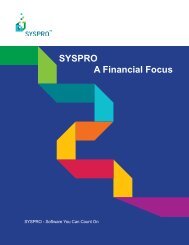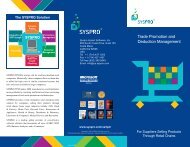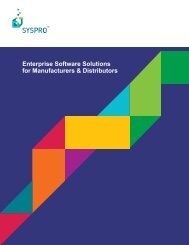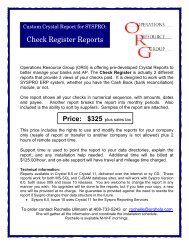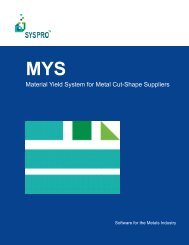Teach Yourself e.net - Syspro
Teach Yourself e.net - Syspro
Teach Yourself e.net - Syspro
You also want an ePaper? Increase the reach of your titles
YUMPU automatically turns print PDFs into web optimized ePapers that Google loves.
Sample Applications<br />
Remember that where ever you see \ at the end of a line of code and the next<br />
line indented, this means that the text was too long for the page size of this<br />
book but the indented text belongs of the code line above.<br />
The above code demonstrates a simple table with four text box fields and a button. There<br />
is obviously a lot more that can be done (like validation rules, password type text boxes,<br />
and foreground/background coloring) but it demonstrates the basic variables needed and<br />
button click sequence that submits that data to the logon SYSPRO business object.<br />
Save the Logon.aspx file from the SampleCode download into your IIS localhost<br />
directory (usually c:\I<strong>net</strong>pub\wwwroot\ or<br />
c:\I<strong>net</strong>pub\wwwroot\<strong>Syspro</strong>web if you are using the SYSPRO web-based<br />
applications). Load the .aspx file in your web browser (usually<br />
http://localhost/Logon.aspx) and use your SYSPRO user details to logon and display your<br />
UserID.<br />
Most of the other business objects require the formation of an XmlIn string and the<br />
translating or presentation of the XmlOut string that is returned by the Object. We have<br />
already covered some of the XML and XSL requirements of e.<strong>net</strong> solutions, and in the<br />
next section we will apply that knowledge using the COMFND business object.<br />
10.2. Submitting XmlIn and getting XmlOut<br />
Having successfully logged on through the code presented in the previous section, we<br />
must now expand our usage of SYSPRO e.<strong>net</strong> solutions. We will utilize the Query.Query<br />
function by using the business object COMFND to demonstrate the use of XmlIn and<br />
XmlOut.<br />
Remember that the e.<strong>net</strong> Diagnostics suite contains a tool within the Harness screen that<br />
will wrap the XmlIn string for use in VB or C#. We have used the wrapping tool, but have<br />
renamed the "With" variable from Document to XmlIn.<br />
10–3





